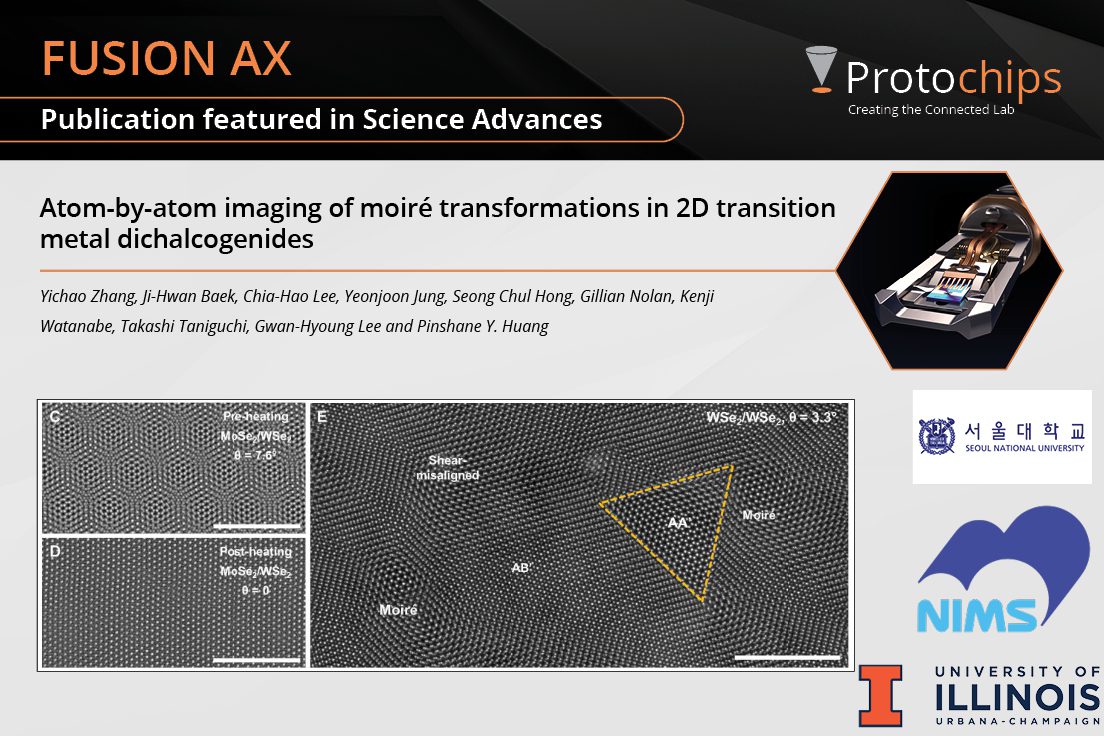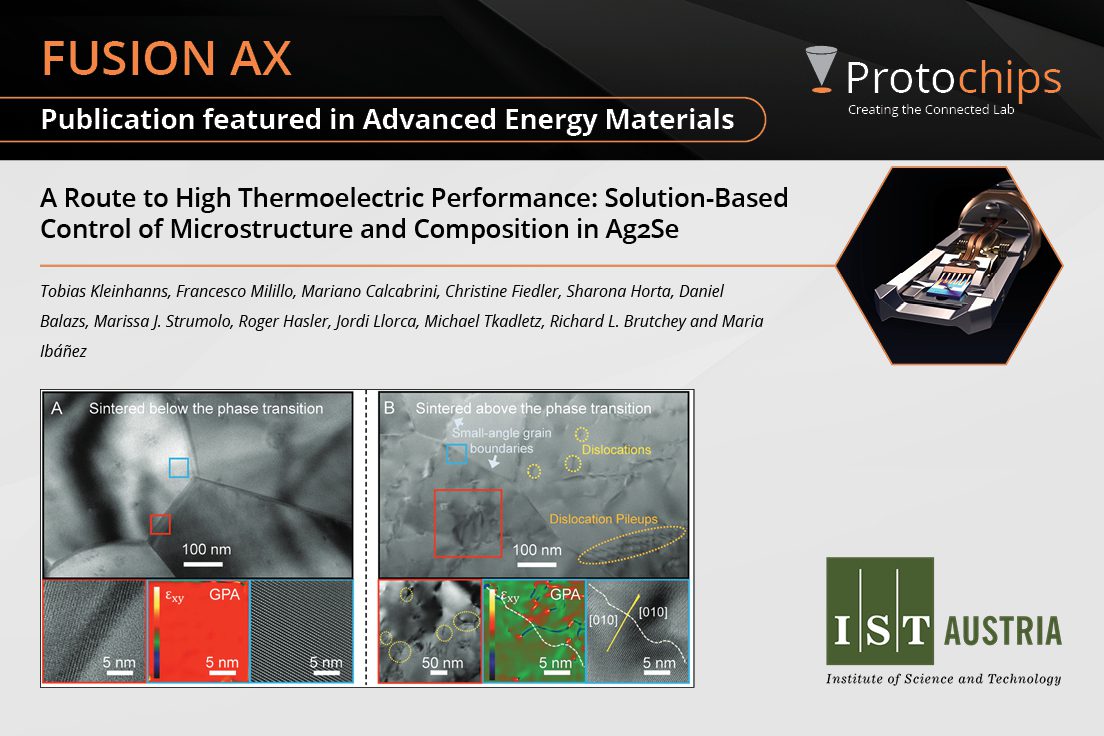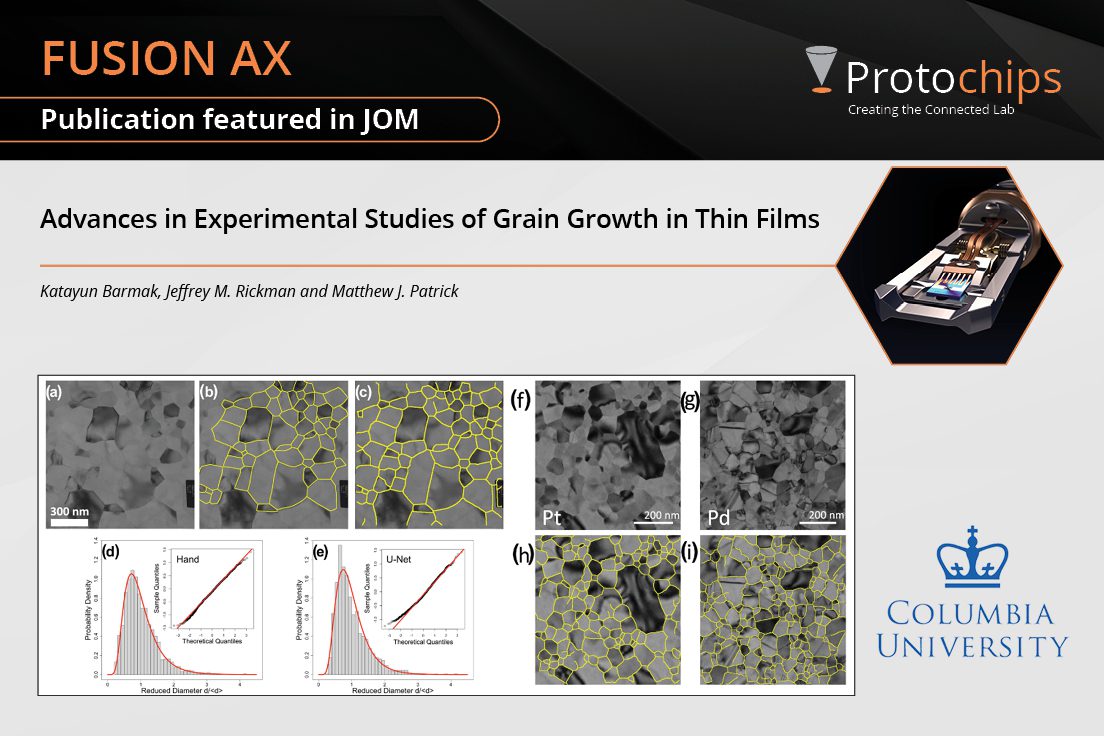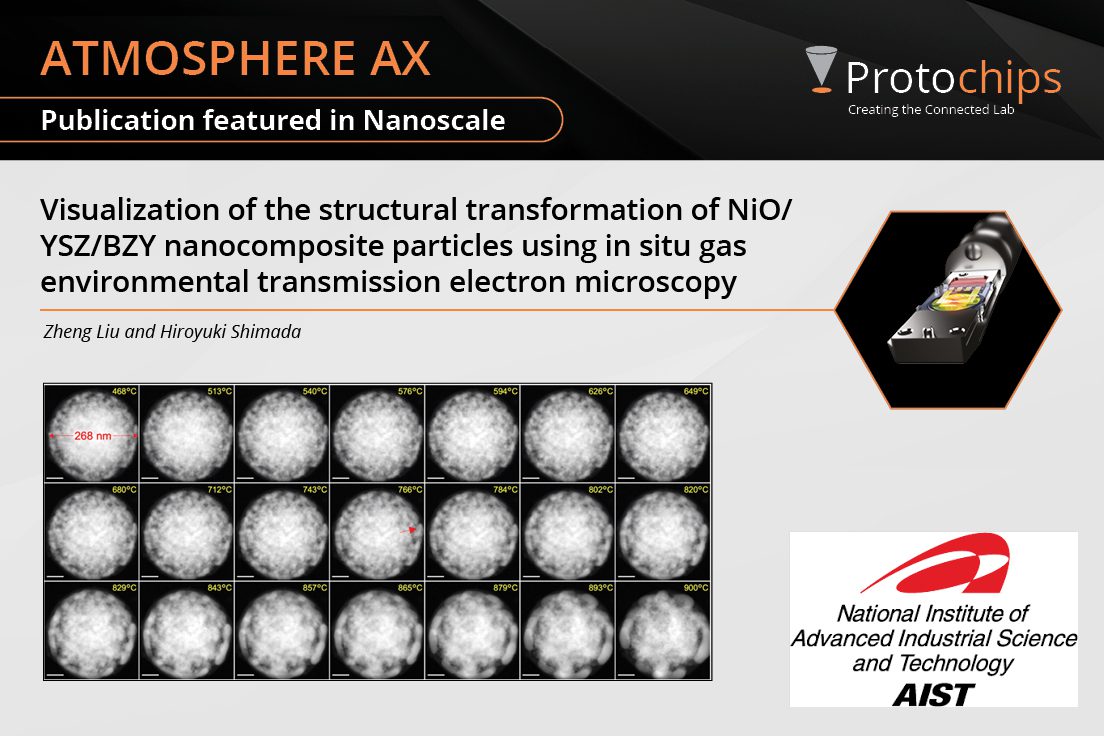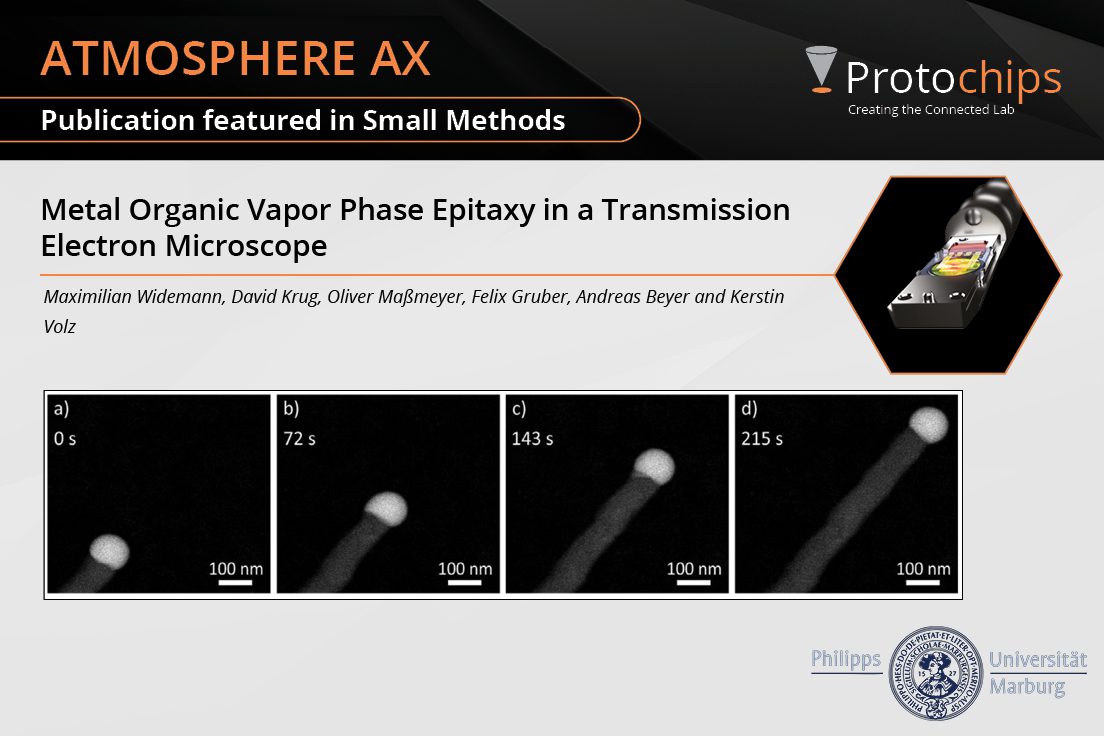
Traditional methods of characterizing the size, morphology and reactivity of nanomaterials often only provide static “snapshots” and require an iterative series of measurements for each condition. With Protochips’ machine-vision powered suite of in-situ TEM tools you can utilize the electron microscope as a real-time laboratory to directly observe nucleation and growth, particle-particle interactions and more.
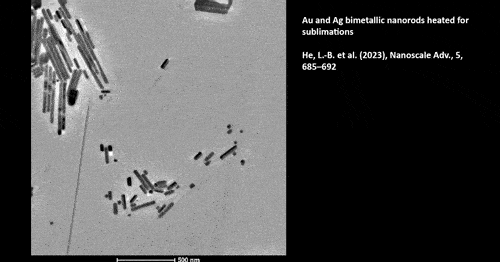
Fusion AX: Study high temperature heating, electrical and electrothermal in vacuum
Visualize the nanoscale processes that control material performance. Observe growth kinetics, degradation mechanisms, grain boundary migrations and more without compromising resolution.
Click here to learn more about our in situ heating and biasing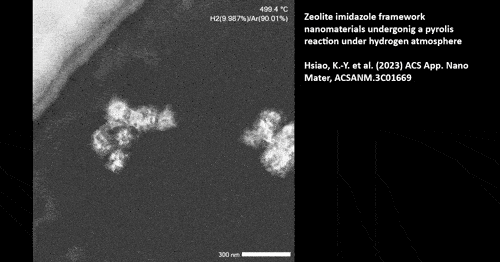
Atmosphere AX: Gas and vapor high temperature environment
Explore synthesis mechanisms, surface reactions and the morphological evolutions that affect your materials’ behavior under relevant temperatures, pressures, and gas conditions without sacrificing resolution.
Click here to learn more about our gas cell solution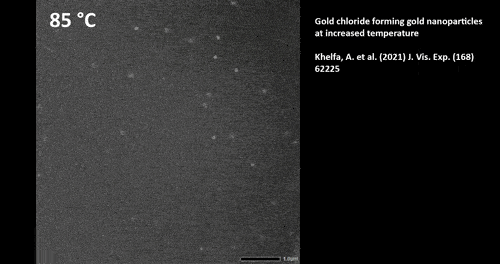
Poseidon AX: Liquid, electrochemical and liquid heating in situ studies
Follow synthesis mechanisms, observe particle interaction, and elucidate how morphological evolution affect your materials performance in relevant solvents and solutions.
Click here to learn more about our liquid cell solutionFeatured Papers
-
News
Artifact-Free Sample Prep...Nov. 12, 2024 -
News
Key Role of Paracrystalli...Sep. 24, 2024 -
News
Spontaneous Liquefaction ...Sep. 3, 2024 -
News
In Situ Heating High-Reso...Jul. 30, 2024 -
News
Atomic-Scale Tracking Top...Jul. 16, 2024 -
News
Atom-by-atom imaging of m...Jun. 25, 2024 -
News
A Route to High Thermoele...May. 14, 2024 -
News
Advances in Experimental ...Apr. 30, 2024 -
News
Visualization of the stru...Mar. 22, 2024 -
News
Metal Organic Vapor Phase...Feb. 12, 2024
What have our users done in the field? Read our summaries here!
-
Materials Science One Pager
Download the one pager that shows how FusionAX can be used to study materials science with in situ electron microscopy.
-
Radiolysis & Liquid-EM
In this application note, written by Protochips, we summarize how in situ electron microscopy using liquid phase is challenged by radiolysis side effects and how to minimize these effects.
-
Using Protochips AXON Software for Tracking Electron Flux and Cumulative Dose
In this paper, we take a look at how AXON Dose tracks the electron flux and cumulative dose, and why this might be useful for all experiments.
-
Imaging gold nanoparticles of different sizes in liquid using TEM
In this summarized paper, researchers from the group of Dr. Niels de Jonge imaged citrate stabilized gold nanoparticles of different sizes using the Poseidon system.
-
Moving Gold Nanoparticles Imaged with Scanning Transmission Electron Microscopy
In this summarized paper, the group of Dr. Niels de Jonge researched the dynamic behaviors of gold nanoparticles using in situ electron microscopy with the Poseidon system.
-
Polyvinyl Pyridine Coated Gold Nanorods Imaged in Liquid
This summarized paper describes the procedure of how to image polyvinyl pyridine coated gold nanorods by researchers from the Indiana University.
-
Dynamic Imaging and Elemental Analysis of Nanostructures in Liquid
In this paper, written by Protochips, nanometer resolution elemental mapping of nanostructures in solution has been demonstrated using the Poseidon system.
-
Understanding the Mechanism of Carbon Nanotube Degradation in Macrophage Cells
In this summarized paper, researchers from the group of Dr. Alloyeau looked at the stability of carbon nanotubes in different liquids to understand the degradation of these materials in macrophage cells.
-
In situ environmental study of perovskite-noble metal catalysts for automotive exhaust control using a Cs corrected TEM
In this summarized paper, Xiaoqing Pan group at University of Michigan performed in situ high-temperature reduction experiments on a CaTi0.95Rh0.05O3 catalyst sample using the Atmosphere system.
-
Simultaneous Electrical and Heating Using Fusion: Electric-Field Assisted Sintering of ZrO2 Nanoparticles
In this summarized paper, researchers in the van Benthem group at University of California, Davis, studied sintering mechanisms in 3mol% yttria-stablized ZrO2 (3YSZ) nanoparticles using Fusion system with electrical biasing capabilities.
-
In Situ FCC to L10 Tetragonal Phase Transition of Magnetic FePt Nanoparticles
Read how Dr. Larry Allard’s lab at Oak Ridge National Laboratory used the Fusion system to observe changes in FePt nanoparticle at various temperatures
-
Atomic Resolution Imaging at High Temperatures in the TEAM 0.5
Read how the TEAM 0.5 TEM at the National Center for Electron Microscopy (NCEM) at Lawrence Berkeley National Laboratory (LBNL) can be used to gain atomic resolution images using a Fusion system.
-
Thermal Stability Study of LAST Thermoelectric Material in the SEM
In this applications note written by Protochips, the capability of the Fusion holder was tested for the thermal and electrical properties of thermoelectric materials.
-
EDS in the TEM and SEM using Fusion
In this applications note written by Protochips, the design of the Fusion holder was tested to show full compatibility with all EDS systems.
-
Thermal Drift and Settle Times Measured for Different Temperature Excursions in the TEM
In this applications note written by Protochips, drift and settle time characteristics of Fusion, two sets of experiments were performed.
Videos
Watch dynamic behavior of real samples in situ.
An Fe nanoparticle etching few-layer graphene (FLG) at 900 degrees C and 600 Torr of H2. The Fe nanoparticle preferentially etches the graphene along specific crystallographic directions.
Credit: SI-IPCMS-CNRS/University of Strasbourg, France: G. Melinte, S. Moldovan and O. Ersen
This real-time video shows two gold nanoparticles that are on the surface of larger iron oxide particles at 900° C. At this temperature the gold is very mobile, and the two particles coalesce into one larger nanoparticle. This demonstrates the stability of the Protochips Fusion system at high temperatures. This video was taken on a JEOL ARM200F (200 kV, Cs aberration correction) at JEOL in Akishima, Japan. For more information on Fusion, visit www.protochips.com/fusion
This is an introduction to the basic performance of the Atmosphere system for conducting in situ environmental TEM studies,
The Poseidon platform enables observation of dynamic processes in situ. This movie shows the formation of salt crystals from a saturated solution of phosphate buffered saline. Images were acquired at a rate of 1 frame per second and are shown at 5 times real speed. 500 nm liquid thickness. Images collected using a Philips/FEI CM300FEG TEM at 300 kV. Courtesy of Dr. Kate Klein, National Institute of Standards and Technology. For more information on Poseidon, visit http://bit.ly/protochipsposeidon.
This workflow explains the procedure for preparing FIB samples onto a MEMS-based E-chip for in situ TEM. FIB sample preparation can be used to prepare a wide variety of materials for TEM or in situ TEM analysis and is a relatively simple technique to learn. For more information, tips and tricks, and sample preparation guides, visit our library of content at www.protochips.com
Learn about Protochips' groundbreaking liquid cell for in situ TEM and STEM.
Video courtesy Dr. Saso Sturm of the Jozef Stefan Institute. Acquired using the Poseidon Select liquid cell holder with liquid heating capability. More info at www.protochips.com
Experiment: Beam-Induced gold deposition from a solution of 1 mM HAuCl4 onto AuPt Nanoparticles. Heating ramp from 25 – 45 C.
Observe the formation of the N12P5 phase from a Ag/NiXPY core-shell nanoparticle. AXON locks the sample at a magnification of 3.5Mx throughout the temperature ramp. See the dynamic transformation to Ni12P5 occur at atomic resolution to determine the precise reaction temperature!
Learn more at http://www.protochips.com/axon
In situ imaging, HAADF-STEM detector, Magnification 3.5Mx, Fusion Select heating holder
A live STEM image stack of Au nanoclusters taken using AXON while ramping through a 100°C temperature range. AXON removes all image instabilities *live* so you can observe even single gold atoms moving on the support while ramping the temperature. Perfect for observing dynamic reactions at the highest resolutions!
Learn more at http://www.protochips.com/axon
in situ imaging, HAADF-STEM detector, Magnification 2.5Mx, Fusion Select heating holder
A live STEM image stack of Au nanoclusters taken using AXON while ramping through a 100°C temperature range. AXON removes all image instabilities *live* so you can observe even single gold atoms moving on the support while ramping the temperature. Perfect for observing dynamic reactions at the highest resolutions!
Learn more at http://www.protochips.com/axon
in situ imaging, HAADF-STEM detector, Magnification 2.5Mx, Fusion Select heating holder
#FindYourBreakthrough | FLASH TALKS: EP #5
High Temperature Dynamics of Nanocrystalline Graphene – A Time Resolved HRTEM Study
Presented by: Dr. C.N. Shyam Kumar while at the Institute of Nanotechnology at Karlsruhe Institute of Technology
Find the full publication here: https://pubs.rsc.org/en/content/articlehtml/2017/nr/c7nr03276e?casa_token=Kd76o5Cy5poAAAAA:Sxeq8iS-FU6guregHJ-QcXM8umNESoRBrpRv5E4KXgMIeXDf-UOcRHyQ3y7hQcQqmol6Q2QEM_e_
#FindYourBreakthrough | FLASH TALKS: EP #7
Catalyst Particle Growth at the Nanoscale
In Situ TEM of TiO2 Supported Gold Nanoparticle Growth
Presented by: Dr. Mark J. Meijerink from Utrecht University. Read the full publication here:
https://pubs.acs.org/doi/10.1021/acs.jpcc.9b10237
In this Flash Talk episode 9 Joanna Korpanty from Northwestern University, Department of Chemistry will tell you something about her recent publication on solvated polymeric nanomaterials in liquid cell electron microscopy. A worm-to-micelle transformation was triggered via organic solvent mixing during the measurements, showing dynamics not possible with cryo-electron microscopy. This work shows great potential in future liquid cell experiments in other solvents then water.
Full publication:
https://linkinghub.elsevier.com/retrieve/pii/S266638642200039X
In this Flash Talk ep. 14, Dr. Diana Piankova from the Max Planck Institute of Colloids and Interfaces is presenting her work on "Following carbon condensation by in situ TEM: Towards a rational understanding of the processes in the synthesis of nitrogen-doped carbonaceous materials."
Read the full publication here:
https://pubs.rsc.org/en/content/articlelanding/2022/ta/d2ta05247d
0:58 Introduction
3:10 Ex-situ study
7:28 In-situ study
10:39 New materials design
#FindYourBreakthrough | FLASH TALKS: EP #16
In situ TEM as toolbox for the emerging science of nanometallurgy
In this flash talk, a methodology for the use of metallic nanomaterials as reactants are used to examine nanoalloying in situ within a transmission electron microscope!
Presented by: Diego Santa Rosa Coradini from Montanuniversität Leoben, group of Nonferrous Metallurgy. Read the full publication here:
https://pubs.rsc.org/en/content/articlelanding/2023/LC/D3LC00228D
Products featured: Protochips FusionAX
In this flash talk, Katy will share her recently published work on automation of grain detection using machine learning. A U-Net convolutional neural network was trained on bright field datasets of polycrystalline materials, and the resulting analysis compared to manual results.
Presented by:
Katayun Barmak, PhD.
Professor, Columbia University
Read the full publication here:
https://doi.org/10.1093/micmic/ozad115
This study tackles a major issue in converting methanol into useful products: the catalyst used in the process tends to wear out quickly due to the buildup of carbon deposits, known as coke. Dr. Sharmin Sharna and collaborators discovered that adding a small amount of liquid gallium, a metal that melts at low temperatures, to a zeolite catalysts, ZSM-5, dramatically improves its durability. The study added methanol in vapor form in the Atmosphere AX system to observe the reduction of carbon buildup on the catalysts' surface. Adding gallium facilitated the removal of carbon, allowing the catalyst to last up to 14 times longer than the original version! This breakthrough could lead to the development of longer-lasting catalysts for the methanol-to-hydrocarbons process, making it more efficient and cost-effective.
Presented by :
Sharmin Sharna, PhD
IPCMS in collaboration with UCCS
Read the full publication here:
https://www.nature.com/articles/s41467-024-46232-9





